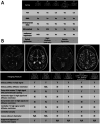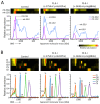This is a preprint.
Biallelic variants in MRPL49 cause variable clinical presentations, including sensorineural hearing loss, leukodystrophy, and ovarian insufficiency
- PMID: 39417135
- PMCID: PMC11483032
- DOI: 10.1101/2024.10.10.24315152
Biallelic variants in MRPL49 cause variable clinical presentations, including sensorineural hearing loss, leukodystrophy, and ovarian insufficiency
Update in
-
Bi-allelic variants in MRPL49 cause variable clinical presentations, including sensorineural hearing loss, leukodystrophy, and ovarian insufficiency.Am J Hum Genet. 2025 Apr 3;112(4):952-962. doi: 10.1016/j.ajhg.2025.02.005. Epub 2025 Mar 4. Am J Hum Genet. 2025. PMID: 40043708 Free PMC article.
Abstract
Combined oxidative phosphorylation deficiency (COXPD) is a rare multisystem disorder which is clinically and genetically heterogeneous. Genome sequencing identified biallelic MRPL49 variants in individuals from five unrelated families with presentations ranging from Perrault syndrome (primary ovarian insufficiency and sensorineural hearing loss) to severe childhood onset of leukodystrophy, learning disability, microcephaly and retinal dystrophy. Complexome profiling of fibroblasts from affected individuals revealed reduced levels of the small and, a more pronounced reduction of, the large mitochondrial ribosomal subunits. There was no evidence of altered mitoribosomal assembly. The reductions in levels of OXPHOS enzyme complexes I and IV are consistent with a form of COXPD associated with biallelic MRPL49 variants, expanding the understanding of how disruption of the mitochondrial ribosomal large subunit results in multi-system phenotypes.
Keywords: MRPL49; Perrault syndrome; combined oxidative phosphorylation deficiency; mitochondrial large ribosomal subunit; mitoribosome; rare disease.
Conflict of interest statement
Declaration of interest: The authors declare no competing interests.
Figures




References
Web Resources
-
- Exome Variant Server, http://evs.gs.washington.edu/EVS/
-
- GeneMatcher, https://genematcher.org/
-
- Ensembl – Variant Effect Predictor, https://www.ensembl.org/Tools/VEP
References
-
- Liu M. & Spremulli L. Interaction of mammalian mitochondrial ribosomes with the inner membrane. J Biol Chem 275, 29400–29406 (2000). - PubMed
-
- Koc E. C. et al. The large subunit of the mammalian mitochondrial ribosome. Analysis of the complement of ribosomal proteins present. J Biol Chem 276, 43958–43969 (2001). - PubMed
-
- Greber B. J. et al. The complete structure of the large subunit of the mammalian mitochondrial ribosome. Nature 515, 283–286 (2014). - PubMed
Publication types
Grants and funding
LinkOut - more resources
Full Text Sources
